Management Information System Report: AI Systems and Decision Making
VerifiedAdded on 2023/06/04
|11
|2784
|275
Report
AI Summary
This report provides an extensive analysis of Artificial Intelligence (AI) systems within the context of Management Information Systems (MIS). It begins by examining various AI technologies, including expert systems, neural networks, fuzzy technologies, and genetic algorithms, highlighting their differences, similarities, and applications in business decision-making. The report then explores the challenges associated with implementing new information technology, such as the need for skilled workers and the investment required. Furthermore, it contrasts the advantages and disadvantages of AI systems compared to traditional processes, offering insights into their impact on organizational efficiency. The report also discusses the ways in which decision support systems add value to organizations and analyzes AI's role in relation to Porter’s value chain theory. Finally, it offers recommendations for adopting AI and decision support systems and concludes by emphasizing the importance of technological measures in achieving organizational goals and enhancing performance.

Running Head: Management Information System
Management Information System
Management Information System
Paraphrase This Document
Need a fresh take? Get an instant paraphrase of this document with our AI Paraphraser
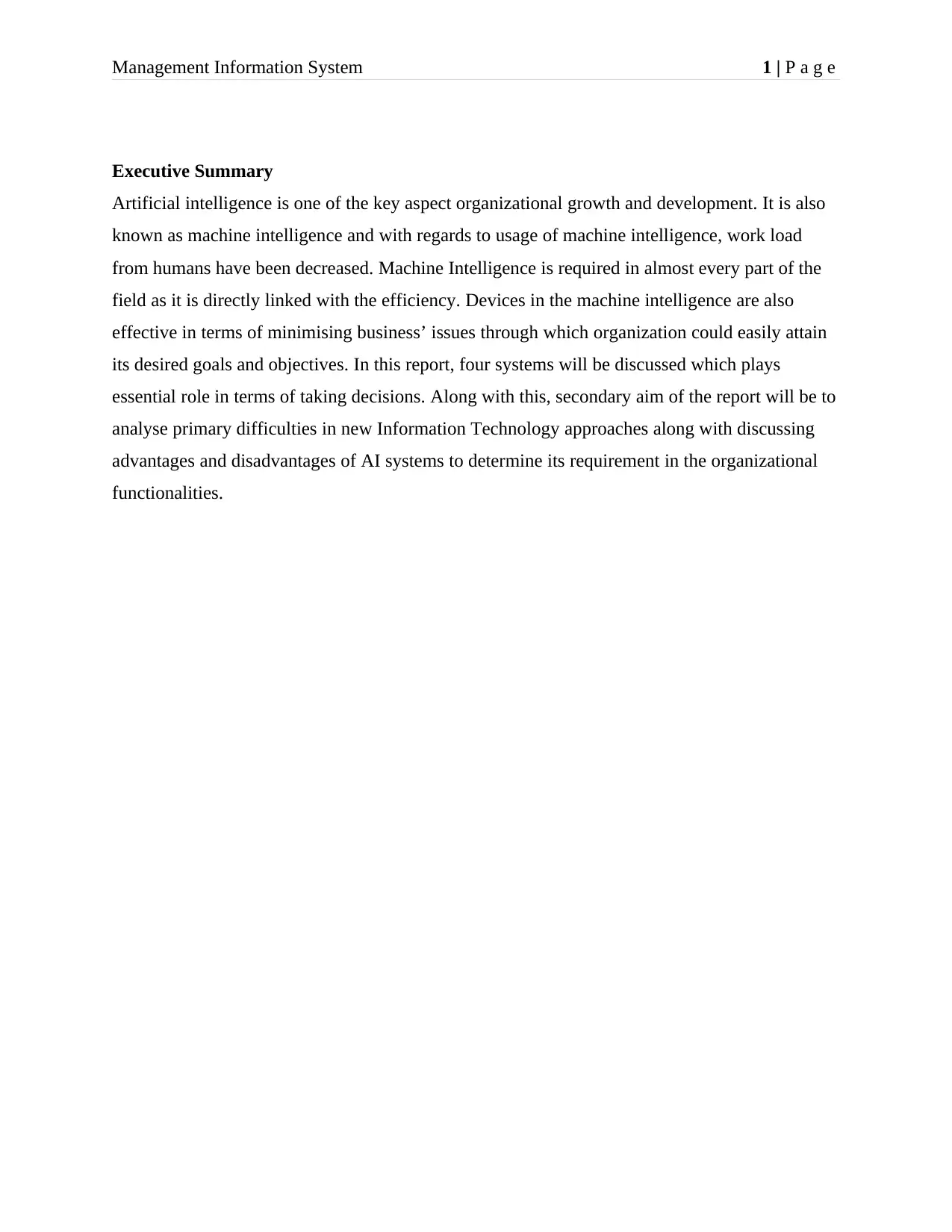
Management Information System 1 | P a g e
Executive Summary
Artificial intelligence is one of the key aspect organizational growth and development. It is also
known as machine intelligence and with regards to usage of machine intelligence, work load
from humans have been decreased. Machine Intelligence is required in almost every part of the
field as it is directly linked with the efficiency. Devices in the machine intelligence are also
effective in terms of minimising business’ issues through which organization could easily attain
its desired goals and objectives. In this report, four systems will be discussed which plays
essential role in terms of taking decisions. Along with this, secondary aim of the report will be to
analyse primary difficulties in new Information Technology approaches along with discussing
advantages and disadvantages of AI systems to determine its requirement in the organizational
functionalities.
Executive Summary
Artificial intelligence is one of the key aspect organizational growth and development. It is also
known as machine intelligence and with regards to usage of machine intelligence, work load
from humans have been decreased. Machine Intelligence is required in almost every part of the
field as it is directly linked with the efficiency. Devices in the machine intelligence are also
effective in terms of minimising business’ issues through which organization could easily attain
its desired goals and objectives. In this report, four systems will be discussed which plays
essential role in terms of taking decisions. Along with this, secondary aim of the report will be to
analyse primary difficulties in new Information Technology approaches along with discussing
advantages and disadvantages of AI systems to determine its requirement in the organizational
functionalities.
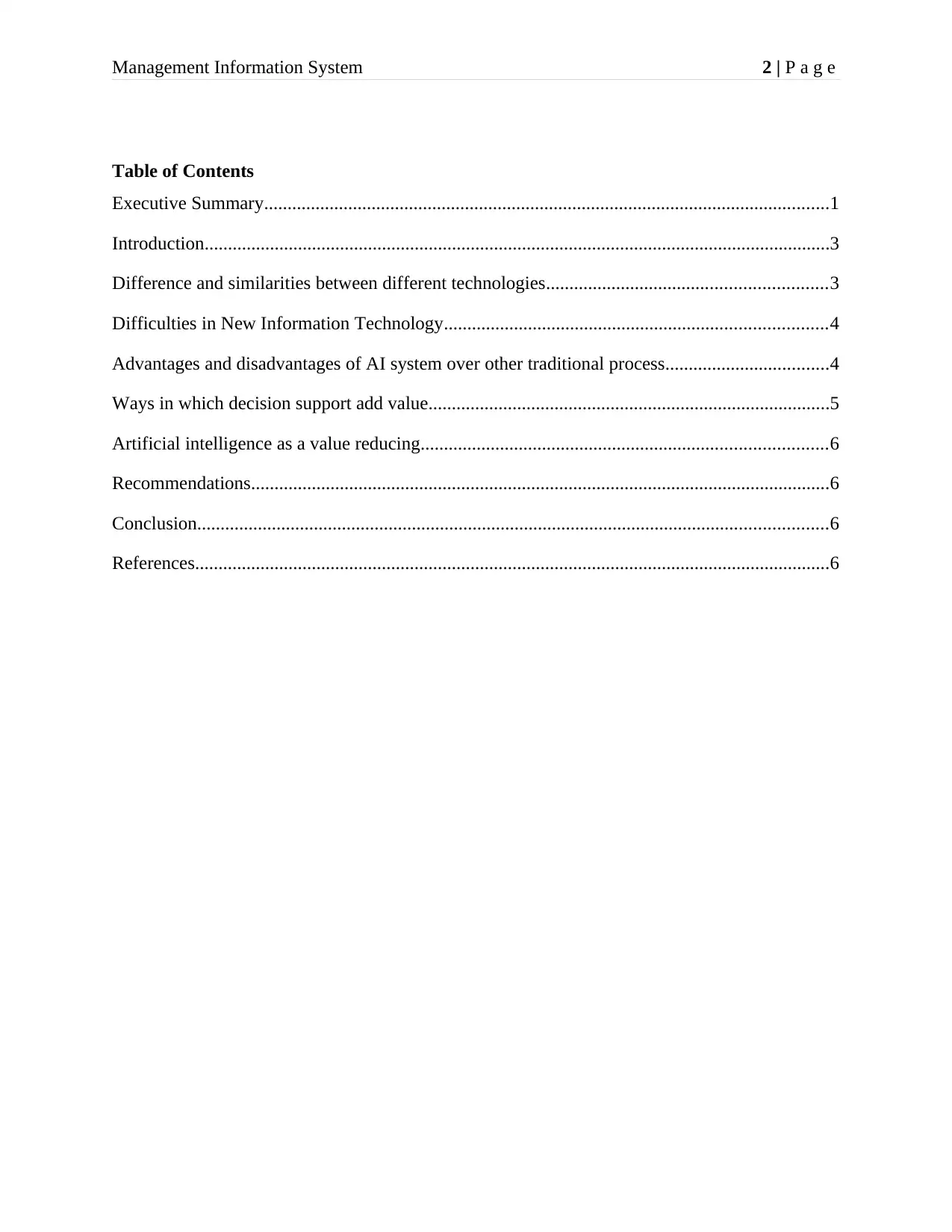
Management Information System 2 | P a g e
Table of Contents
Executive Summary.........................................................................................................................1
Introduction......................................................................................................................................3
Difference and similarities between different technologies............................................................3
Difficulties in New Information Technology..................................................................................4
Advantages and disadvantages of AI system over other traditional process...................................4
Ways in which decision support add value......................................................................................5
Artificial intelligence as a value reducing.......................................................................................6
Recommendations............................................................................................................................6
Conclusion.......................................................................................................................................6
References........................................................................................................................................6
Table of Contents
Executive Summary.........................................................................................................................1
Introduction......................................................................................................................................3
Difference and similarities between different technologies............................................................3
Difficulties in New Information Technology..................................................................................4
Advantages and disadvantages of AI system over other traditional process...................................4
Ways in which decision support add value......................................................................................5
Artificial intelligence as a value reducing.......................................................................................6
Recommendations............................................................................................................................6
Conclusion.......................................................................................................................................6
References........................................................................................................................................6
⊘ This is a preview!⊘
Do you want full access?
Subscribe today to unlock all pages.

Trusted by 1+ million students worldwide
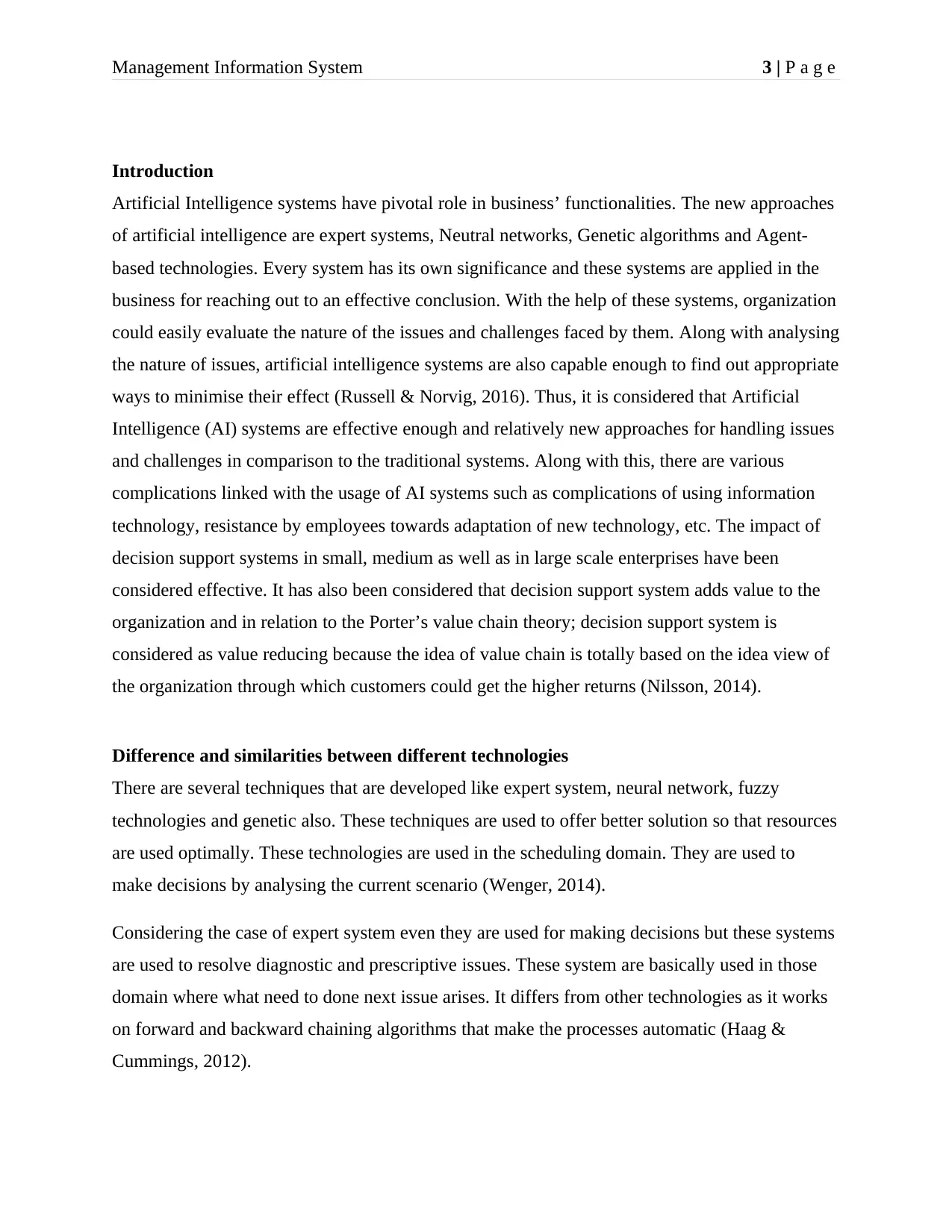
Management Information System 3 | P a g e
Introduction
Artificial Intelligence systems have pivotal role in business’ functionalities. The new approaches
of artificial intelligence are expert systems, Neutral networks, Genetic algorithms and Agent-
based technologies. Every system has its own significance and these systems are applied in the
business for reaching out to an effective conclusion. With the help of these systems, organization
could easily evaluate the nature of the issues and challenges faced by them. Along with analysing
the nature of issues, artificial intelligence systems are also capable enough to find out appropriate
ways to minimise their effect (Russell & Norvig, 2016). Thus, it is considered that Artificial
Intelligence (AI) systems are effective enough and relatively new approaches for handling issues
and challenges in comparison to the traditional systems. Along with this, there are various
complications linked with the usage of AI systems such as complications of using information
technology, resistance by employees towards adaptation of new technology, etc. The impact of
decision support systems in small, medium as well as in large scale enterprises have been
considered effective. It has also been considered that decision support system adds value to the
organization and in relation to the Porter’s value chain theory; decision support system is
considered as value reducing because the idea of value chain is totally based on the idea view of
the organization through which customers could get the higher returns (Nilsson, 2014).
Difference and similarities between different technologies
There are several techniques that are developed like expert system, neural network, fuzzy
technologies and genetic also. These techniques are used to offer better solution so that resources
are used optimally. These technologies are used in the scheduling domain. They are used to
make decisions by analysing the current scenario (Wenger, 2014).
Considering the case of expert system even they are used for making decisions but these systems
are used to resolve diagnostic and prescriptive issues. These system are basically used in those
domain where what need to done next issue arises. It differs from other technologies as it works
on forward and backward chaining algorithms that make the processes automatic (Haag &
Cummings, 2012).
Introduction
Artificial Intelligence systems have pivotal role in business’ functionalities. The new approaches
of artificial intelligence are expert systems, Neutral networks, Genetic algorithms and Agent-
based technologies. Every system has its own significance and these systems are applied in the
business for reaching out to an effective conclusion. With the help of these systems, organization
could easily evaluate the nature of the issues and challenges faced by them. Along with analysing
the nature of issues, artificial intelligence systems are also capable enough to find out appropriate
ways to minimise their effect (Russell & Norvig, 2016). Thus, it is considered that Artificial
Intelligence (AI) systems are effective enough and relatively new approaches for handling issues
and challenges in comparison to the traditional systems. Along with this, there are various
complications linked with the usage of AI systems such as complications of using information
technology, resistance by employees towards adaptation of new technology, etc. The impact of
decision support systems in small, medium as well as in large scale enterprises have been
considered effective. It has also been considered that decision support system adds value to the
organization and in relation to the Porter’s value chain theory; decision support system is
considered as value reducing because the idea of value chain is totally based on the idea view of
the organization through which customers could get the higher returns (Nilsson, 2014).
Difference and similarities between different technologies
There are several techniques that are developed like expert system, neural network, fuzzy
technologies and genetic also. These techniques are used to offer better solution so that resources
are used optimally. These technologies are used in the scheduling domain. They are used to
make decisions by analysing the current scenario (Wenger, 2014).
Considering the case of expert system even they are used for making decisions but these systems
are used to resolve diagnostic and prescriptive issues. These system are basically used in those
domain where what need to done next issue arises. It differs from other technologies as it works
on forward and backward chaining algorithms that make the processes automatic (Haag &
Cummings, 2012).
Paraphrase This Document
Need a fresh take? Get an instant paraphrase of this document with our AI Paraphraser

Management Information System 4 | P a g e
In case of neural networks, the analysis and learning traits are implemented using many
processors called neurons. For making decision they learn from progress experience and adapt to
environmental fluctuations. In many cases, the time taken for making decisions could be high as
it depends upon the size of neural network (Steels & Brooks, 2018).
The fuzzy technologies make use of fuzzy sets to solve certain phenomena. They connect the
fuzzy sets through fuzzy rules so that numeric results are obtained. It is basically used in control
system applications so that human controls could be reduced. It makes the decisions by
considering 0 and 1 logics. Theses system is used to resolve all the mathematical problems by
balancing the real time situation with simulation.
The genetic algorithm works on certain rules and their cross over rules. They modify set of rules
so that the objectives can be met by solving the problems in an optimized way. They are different
from other technique as they work on checking all the factors so that improvement could be
done. It is one of the optimizing systems that evaluate the package of decision characteristics
(Ghahramani, 2015).
Difficulties in New Information Technology
Every organization is unique in their terms and with regards to this, they are required to adopt
technologies and other measures on the basis of their requirements. Thus, it seems to be
necessary and effective for the organizations to make their functionalities efficient enough to
attain growth and development related goals and objectives. With the introduction of
globalisation, every organization has adopted the way of being unique to gain competitive
advantage. In terms of being unique, several have opted technological way while several
companies have opted for creative and innovative measures which are also linked with the
information technology at some point. With regards to the adaptation of information technology
for enhancing organizational performance as well as gaining competitive advantage,
organizations and their managers are required to analyse that which technology suits their
business. New technologies available for the businesses in today’s world are cloud, big data,
mobility, and virtualisation and in relation with this, organization requires to decide which option
is more suitable (Burbules, 2018).
In case of neural networks, the analysis and learning traits are implemented using many
processors called neurons. For making decision they learn from progress experience and adapt to
environmental fluctuations. In many cases, the time taken for making decisions could be high as
it depends upon the size of neural network (Steels & Brooks, 2018).
The fuzzy technologies make use of fuzzy sets to solve certain phenomena. They connect the
fuzzy sets through fuzzy rules so that numeric results are obtained. It is basically used in control
system applications so that human controls could be reduced. It makes the decisions by
considering 0 and 1 logics. Theses system is used to resolve all the mathematical problems by
balancing the real time situation with simulation.
The genetic algorithm works on certain rules and their cross over rules. They modify set of rules
so that the objectives can be met by solving the problems in an optimized way. They are different
from other technique as they work on checking all the factors so that improvement could be
done. It is one of the optimizing systems that evaluate the package of decision characteristics
(Ghahramani, 2015).
Difficulties in New Information Technology
Every organization is unique in their terms and with regards to this, they are required to adopt
technologies and other measures on the basis of their requirements. Thus, it seems to be
necessary and effective for the organizations to make their functionalities efficient enough to
attain growth and development related goals and objectives. With the introduction of
globalisation, every organization has adopted the way of being unique to gain competitive
advantage. In terms of being unique, several have opted technological way while several
companies have opted for creative and innovative measures which are also linked with the
information technology at some point. With regards to the adaptation of information technology
for enhancing organizational performance as well as gaining competitive advantage,
organizations and their managers are required to analyse that which technology suits their
business. New technologies available for the businesses in today’s world are cloud, big data,
mobility, and virtualisation and in relation with this, organization requires to decide which option
is more suitable (Burbules, 2018).

Management Information System 5 | P a g e
With the increasing use of advanced technology the challenges have also increased. The new and
advanced technology requires skilled and talented workers at the workplace so that they can
maintain and work effectively. The lack of well-trained employees directly affects the progress
of business. The use of information technology has also increased higher expectations. On the
other hand, it has replaced the need of workers as most of the task is completed automatically
(Brown & Duguid, 2017).
One the major challenge that is faced due to advanced information system is over hype. It causes
the issue that employees and workers are not able to share their view points as all the decisions
are made automatically. The Artificial intelligence causes lack of people power as highly skilled
employees are needed but shortage of advanced skill worker is faced. The other issue faced due
to new information system is investment required to set up the technology in the system. It is
also true that no technology is perfect, there are some flaws but in new an advanced technology it
has become difficult to trace the concerns. As new technology operates on a pre-defined
algorithm thus it becomes difficult to blame anyone about the flaws (Long, 2018).
Advantages and disadvantages of AI system over other traditional process
The expert system faces various advantages and disadvantages as compared to traditional
process, the main benefit is consistency. It helps in making same decisions without refining the
rules again and again. The other benefit is memory as expert system has a large amount of
knowledge that could be accessed easily. The disadvantage of using expert system is time and
cost as compared to traditional system. Apart from that, expert system needs to be developed for
specific domain (Lazaroiu, 2015).
The neural networks also face various gains and difficulties as compared to traditional process.
The benefits gained through neural network are that it requires formal training so that complex
issues could be resolved. It offers various features like logistic regression and ability to detect
possible interactions. The difficulties that are faced are over fitting into the development model.
It also needs high processing time as neural networks are massive and once they are required to
be analysed by humans (Wenger, 2014).
With the increasing use of advanced technology the challenges have also increased. The new and
advanced technology requires skilled and talented workers at the workplace so that they can
maintain and work effectively. The lack of well-trained employees directly affects the progress
of business. The use of information technology has also increased higher expectations. On the
other hand, it has replaced the need of workers as most of the task is completed automatically
(Brown & Duguid, 2017).
One the major challenge that is faced due to advanced information system is over hype. It causes
the issue that employees and workers are not able to share their view points as all the decisions
are made automatically. The Artificial intelligence causes lack of people power as highly skilled
employees are needed but shortage of advanced skill worker is faced. The other issue faced due
to new information system is investment required to set up the technology in the system. It is
also true that no technology is perfect, there are some flaws but in new an advanced technology it
has become difficult to trace the concerns. As new technology operates on a pre-defined
algorithm thus it becomes difficult to blame anyone about the flaws (Long, 2018).
Advantages and disadvantages of AI system over other traditional process
The expert system faces various advantages and disadvantages as compared to traditional
process, the main benefit is consistency. It helps in making same decisions without refining the
rules again and again. The other benefit is memory as expert system has a large amount of
knowledge that could be accessed easily. The disadvantage of using expert system is time and
cost as compared to traditional system. Apart from that, expert system needs to be developed for
specific domain (Lazaroiu, 2015).
The neural networks also face various gains and difficulties as compared to traditional process.
The benefits gained through neural network are that it requires formal training so that complex
issues could be resolved. It offers various features like logistic regression and ability to detect
possible interactions. The difficulties that are faced are over fitting into the development model.
It also needs high processing time as neural networks are massive and once they are required to
be analysed by humans (Wenger, 2014).
⊘ This is a preview!⊘
Do you want full access?
Subscribe today to unlock all pages.

Trusted by 1+ million students worldwide
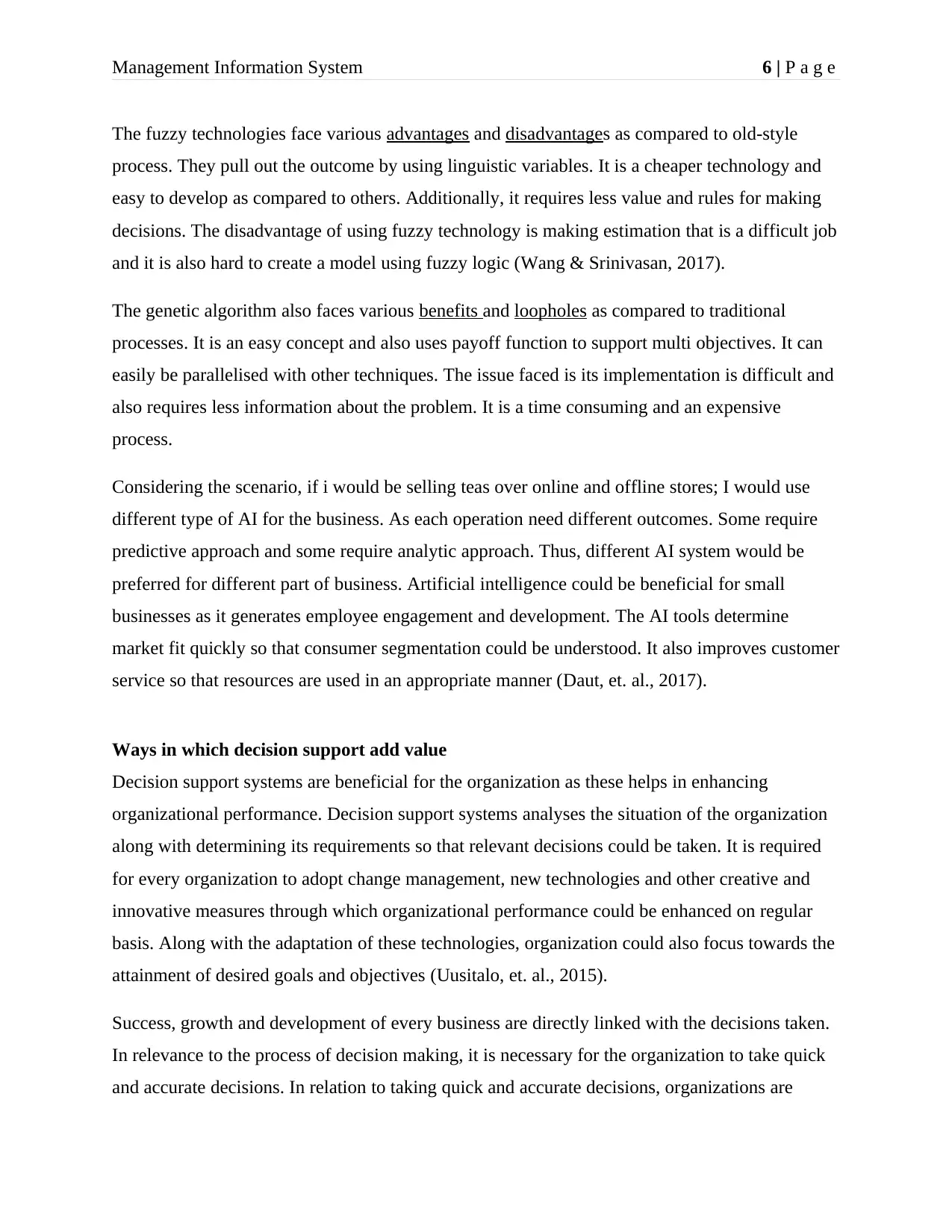
Management Information System 6 | P a g e
The fuzzy technologies face various advantages and disadvantages as compared to old-style
process. They pull out the outcome by using linguistic variables. It is a cheaper technology and
easy to develop as compared to others. Additionally, it requires less value and rules for making
decisions. The disadvantage of using fuzzy technology is making estimation that is a difficult job
and it is also hard to create a model using fuzzy logic (Wang & Srinivasan, 2017).
The genetic algorithm also faces various benefits and loopholes as compared to traditional
processes. It is an easy concept and also uses payoff function to support multi objectives. It can
easily be parallelised with other techniques. The issue faced is its implementation is difficult and
also requires less information about the problem. It is a time consuming and an expensive
process.
Considering the scenario, if i would be selling teas over online and offline stores; I would use
different type of AI for the business. As each operation need different outcomes. Some require
predictive approach and some require analytic approach. Thus, different AI system would be
preferred for different part of business. Artificial intelligence could be beneficial for small
businesses as it generates employee engagement and development. The AI tools determine
market fit quickly so that consumer segmentation could be understood. It also improves customer
service so that resources are used in an appropriate manner (Daut, et. al., 2017).
Ways in which decision support add value
Decision support systems are beneficial for the organization as these helps in enhancing
organizational performance. Decision support systems analyses the situation of the organization
along with determining its requirements so that relevant decisions could be taken. It is required
for every organization to adopt change management, new technologies and other creative and
innovative measures through which organizational performance could be enhanced on regular
basis. Along with the adaptation of these technologies, organization could also focus towards the
attainment of desired goals and objectives (Uusitalo, et. al., 2015).
Success, growth and development of every business are directly linked with the decisions taken.
In relevance to the process of decision making, it is necessary for the organization to take quick
and accurate decisions. In relation to taking quick and accurate decisions, organizations are
The fuzzy technologies face various advantages and disadvantages as compared to old-style
process. They pull out the outcome by using linguistic variables. It is a cheaper technology and
easy to develop as compared to others. Additionally, it requires less value and rules for making
decisions. The disadvantage of using fuzzy technology is making estimation that is a difficult job
and it is also hard to create a model using fuzzy logic (Wang & Srinivasan, 2017).
The genetic algorithm also faces various benefits and loopholes as compared to traditional
processes. It is an easy concept and also uses payoff function to support multi objectives. It can
easily be parallelised with other techniques. The issue faced is its implementation is difficult and
also requires less information about the problem. It is a time consuming and an expensive
process.
Considering the scenario, if i would be selling teas over online and offline stores; I would use
different type of AI for the business. As each operation need different outcomes. Some require
predictive approach and some require analytic approach. Thus, different AI system would be
preferred for different part of business. Artificial intelligence could be beneficial for small
businesses as it generates employee engagement and development. The AI tools determine
market fit quickly so that consumer segmentation could be understood. It also improves customer
service so that resources are used in an appropriate manner (Daut, et. al., 2017).
Ways in which decision support add value
Decision support systems are beneficial for the organization as these helps in enhancing
organizational performance. Decision support systems analyses the situation of the organization
along with determining its requirements so that relevant decisions could be taken. It is required
for every organization to adopt change management, new technologies and other creative and
innovative measures through which organizational performance could be enhanced on regular
basis. Along with the adaptation of these technologies, organization could also focus towards the
attainment of desired goals and objectives (Uusitalo, et. al., 2015).
Success, growth and development of every business are directly linked with the decisions taken.
In relevance to the process of decision making, it is necessary for the organization to take quick
and accurate decisions. In relation to taking quick and accurate decisions, organizations are
Paraphrase This Document
Need a fresh take? Get an instant paraphrase of this document with our AI Paraphraser
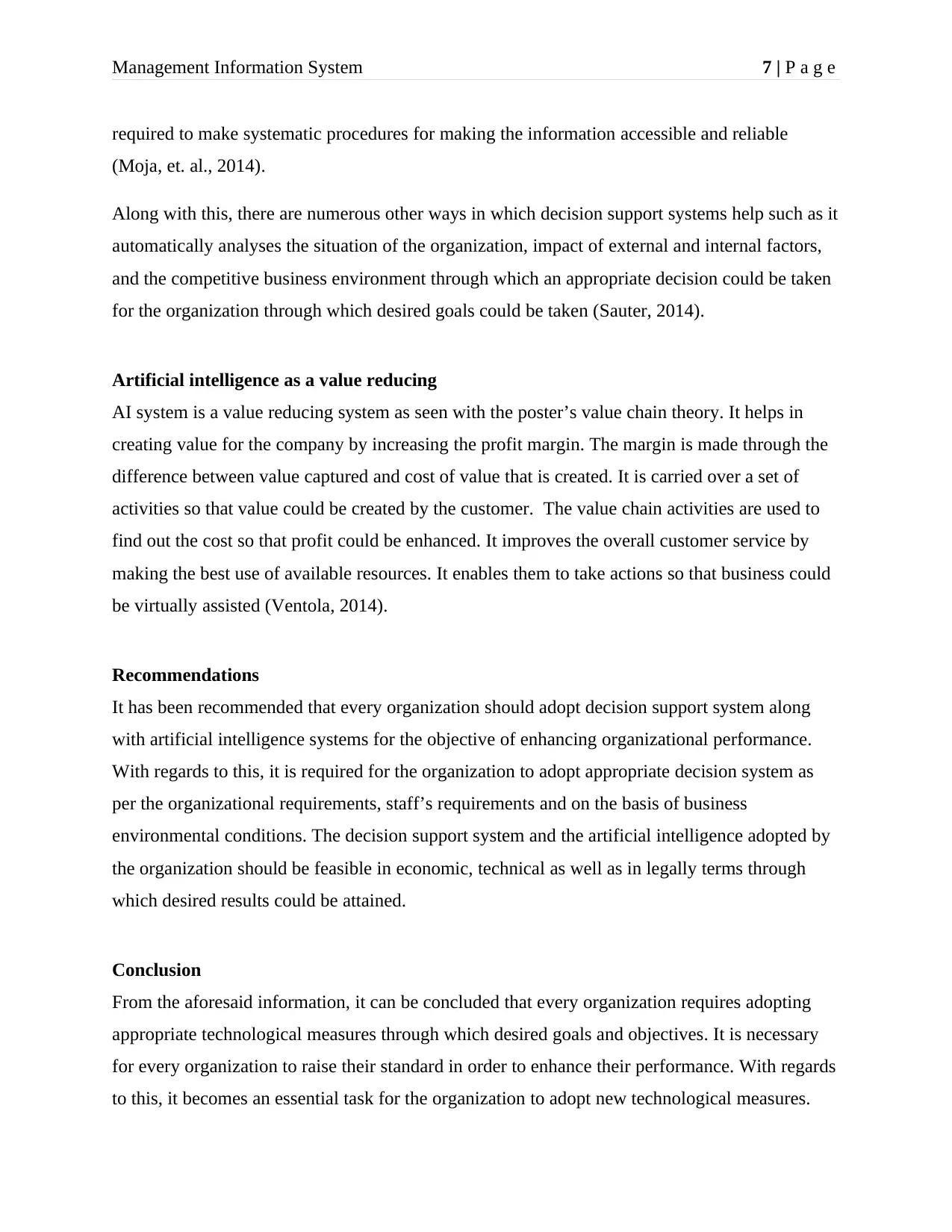
Management Information System 7 | P a g e
required to make systematic procedures for making the information accessible and reliable
(Moja, et. al., 2014).
Along with this, there are numerous other ways in which decision support systems help such as it
automatically analyses the situation of the organization, impact of external and internal factors,
and the competitive business environment through which an appropriate decision could be taken
for the organization through which desired goals could be taken (Sauter, 2014).
Artificial intelligence as a value reducing
AI system is a value reducing system as seen with the poster’s value chain theory. It helps in
creating value for the company by increasing the profit margin. The margin is made through the
difference between value captured and cost of value that is created. It is carried over a set of
activities so that value could be created by the customer. The value chain activities are used to
find out the cost so that profit could be enhanced. It improves the overall customer service by
making the best use of available resources. It enables them to take actions so that business could
be virtually assisted (Ventola, 2014).
Recommendations
It has been recommended that every organization should adopt decision support system along
with artificial intelligence systems for the objective of enhancing organizational performance.
With regards to this, it is required for the organization to adopt appropriate decision system as
per the organizational requirements, staff’s requirements and on the basis of business
environmental conditions. The decision support system and the artificial intelligence adopted by
the organization should be feasible in economic, technical as well as in legally terms through
which desired results could be attained.
Conclusion
From the aforesaid information, it can be concluded that every organization requires adopting
appropriate technological measures through which desired goals and objectives. It is necessary
for every organization to raise their standard in order to enhance their performance. With regards
to this, it becomes an essential task for the organization to adopt new technological measures.
required to make systematic procedures for making the information accessible and reliable
(Moja, et. al., 2014).
Along with this, there are numerous other ways in which decision support systems help such as it
automatically analyses the situation of the organization, impact of external and internal factors,
and the competitive business environment through which an appropriate decision could be taken
for the organization through which desired goals could be taken (Sauter, 2014).
Artificial intelligence as a value reducing
AI system is a value reducing system as seen with the poster’s value chain theory. It helps in
creating value for the company by increasing the profit margin. The margin is made through the
difference between value captured and cost of value that is created. It is carried over a set of
activities so that value could be created by the customer. The value chain activities are used to
find out the cost so that profit could be enhanced. It improves the overall customer service by
making the best use of available resources. It enables them to take actions so that business could
be virtually assisted (Ventola, 2014).
Recommendations
It has been recommended that every organization should adopt decision support system along
with artificial intelligence systems for the objective of enhancing organizational performance.
With regards to this, it is required for the organization to adopt appropriate decision system as
per the organizational requirements, staff’s requirements and on the basis of business
environmental conditions. The decision support system and the artificial intelligence adopted by
the organization should be feasible in economic, technical as well as in legally terms through
which desired results could be attained.
Conclusion
From the aforesaid information, it can be concluded that every organization requires adopting
appropriate technological measures through which desired goals and objectives. It is necessary
for every organization to raise their standard in order to enhance their performance. With regards
to this, it becomes an essential task for the organization to adopt new technological measures.

Management Information System 8 | P a g e
These measures also help the organization to gain competitive advantage along with making the
organization effective enough to deal with different scenarios in order to match up with the
expectations of the organization.
These measures also help the organization to gain competitive advantage along with making the
organization effective enough to deal with different scenarios in order to match up with the
expectations of the organization.
⊘ This is a preview!⊘
Do you want full access?
Subscribe today to unlock all pages.

Trusted by 1+ million students worldwide

Management Information System 9 | P a g e
References
Brown, J.S. and Duguid, P., 2017. The Social Life of Information: Updated, with a New Preface.
Harvard Business Review Press.
Burbules, N., 2018. Watch IT: The risks and promises of information technologies for education.
Routledge.
Daut, M.A.M., Hassan, M.Y., Abdullah, H., Rahman, H.A., Abdullah, M.P. and Hussin, F.,
2017. Building electrical energy consumption forecasting analysis using conventional and
artificial intelligence methods: A review. Renewable and Sustainable Energy Reviews, 70(3),
pp.1108-1118.
Ghahramani, Z., 2015. Probabilistic machine learning and artificial
intelligence. Nature, 521(7553), p.452.
Haag, S. & Cummings, M. 2012. Management Information Systems for the information age.
9(6). McGraw-Hill Higher Education.
Lazaroiu, G., 2015. Employee motivation and job performance. Linguistic and Philosophical
Investigations, 14(5), p.97.
Long, R.J., 2018. New office information technology: Human and managerial implications.
Routledge.
Moja, L., Kwag, K.H., Lytras, T., Bertizzolo, L., Brandt, L., Pecoraro, V., Rigon, G., Vaona, A.,
Ruggiero, F., Mangia, M. and Iorio, A., 2014. Effectiveness of computerized decision support
systems linked to electronic health records: a systematic review and meta-analysis. American
journal of public health, 104(12), pp.e12-e22.
Nilsson, N.J., 2014. Principles of artificial intelligence. Morgan Kaufmann.
Russell, S.J. and Norvig, P., 2016. Artificial intelligence: a modern approach. Malaysia; Pearson
Education Limited,.
Sauter, V.L., 2014. Decision support systems for business intelligence. John Wiley & Sons.
References
Brown, J.S. and Duguid, P., 2017. The Social Life of Information: Updated, with a New Preface.
Harvard Business Review Press.
Burbules, N., 2018. Watch IT: The risks and promises of information technologies for education.
Routledge.
Daut, M.A.M., Hassan, M.Y., Abdullah, H., Rahman, H.A., Abdullah, M.P. and Hussin, F.,
2017. Building electrical energy consumption forecasting analysis using conventional and
artificial intelligence methods: A review. Renewable and Sustainable Energy Reviews, 70(3),
pp.1108-1118.
Ghahramani, Z., 2015. Probabilistic machine learning and artificial
intelligence. Nature, 521(7553), p.452.
Haag, S. & Cummings, M. 2012. Management Information Systems for the information age.
9(6). McGraw-Hill Higher Education.
Lazaroiu, G., 2015. Employee motivation and job performance. Linguistic and Philosophical
Investigations, 14(5), p.97.
Long, R.J., 2018. New office information technology: Human and managerial implications.
Routledge.
Moja, L., Kwag, K.H., Lytras, T., Bertizzolo, L., Brandt, L., Pecoraro, V., Rigon, G., Vaona, A.,
Ruggiero, F., Mangia, M. and Iorio, A., 2014. Effectiveness of computerized decision support
systems linked to electronic health records: a systematic review and meta-analysis. American
journal of public health, 104(12), pp.e12-e22.
Nilsson, N.J., 2014. Principles of artificial intelligence. Morgan Kaufmann.
Russell, S.J. and Norvig, P., 2016. Artificial intelligence: a modern approach. Malaysia; Pearson
Education Limited,.
Sauter, V.L., 2014. Decision support systems for business intelligence. John Wiley & Sons.
Paraphrase This Document
Need a fresh take? Get an instant paraphrase of this document with our AI Paraphraser
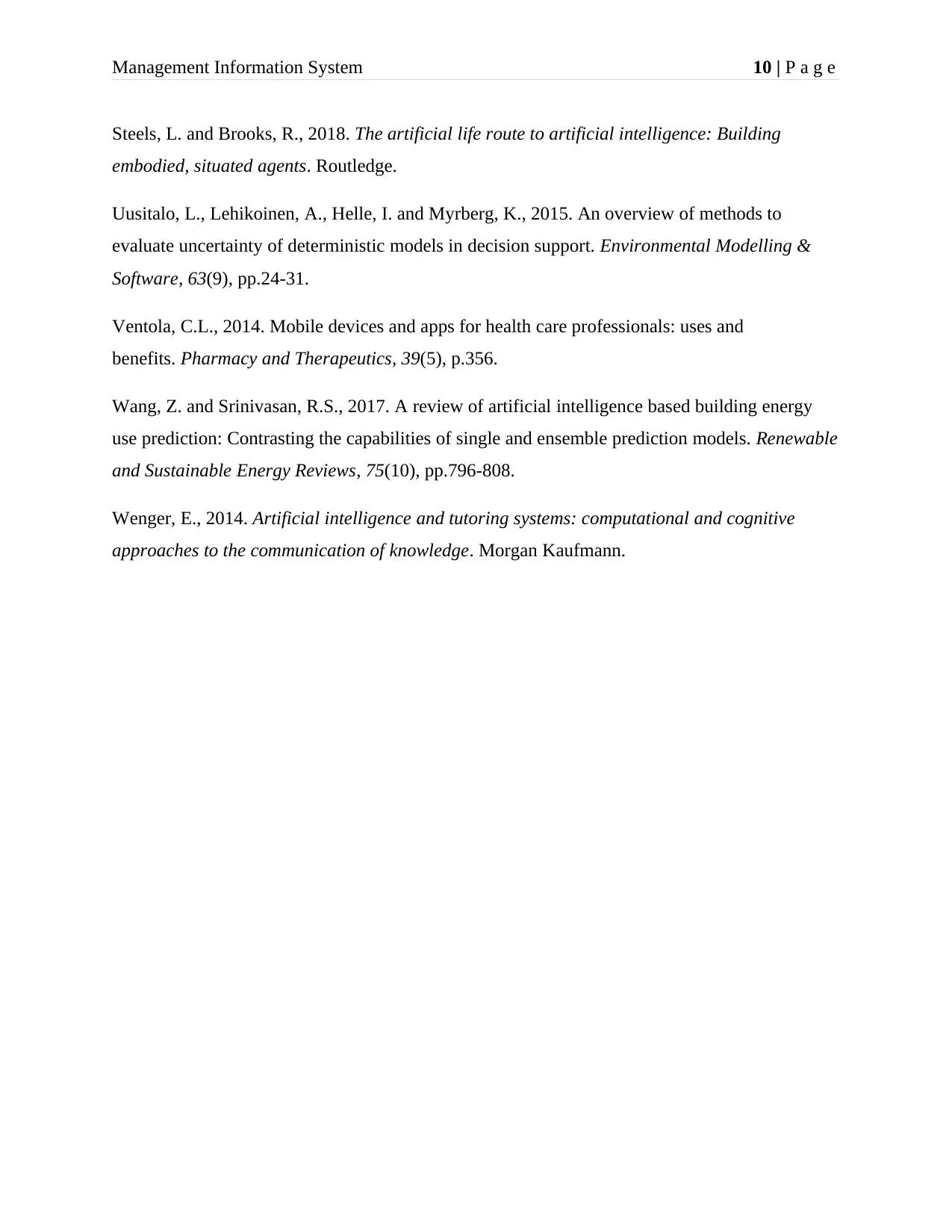
Management Information System 10 | P a g e
Steels, L. and Brooks, R., 2018. The artificial life route to artificial intelligence: Building
embodied, situated agents. Routledge.
Uusitalo, L., Lehikoinen, A., Helle, I. and Myrberg, K., 2015. An overview of methods to
evaluate uncertainty of deterministic models in decision support. Environmental Modelling &
Software, 63(9), pp.24-31.
Ventola, C.L., 2014. Mobile devices and apps for health care professionals: uses and
benefits. Pharmacy and Therapeutics, 39(5), p.356.
Wang, Z. and Srinivasan, R.S., 2017. A review of artificial intelligence based building energy
use prediction: Contrasting the capabilities of single and ensemble prediction models. Renewable
and Sustainable Energy Reviews, 75(10), pp.796-808.
Wenger, E., 2014. Artificial intelligence and tutoring systems: computational and cognitive
approaches to the communication of knowledge. Morgan Kaufmann.
Steels, L. and Brooks, R., 2018. The artificial life route to artificial intelligence: Building
embodied, situated agents. Routledge.
Uusitalo, L., Lehikoinen, A., Helle, I. and Myrberg, K., 2015. An overview of methods to
evaluate uncertainty of deterministic models in decision support. Environmental Modelling &
Software, 63(9), pp.24-31.
Ventola, C.L., 2014. Mobile devices and apps for health care professionals: uses and
benefits. Pharmacy and Therapeutics, 39(5), p.356.
Wang, Z. and Srinivasan, R.S., 2017. A review of artificial intelligence based building energy
use prediction: Contrasting the capabilities of single and ensemble prediction models. Renewable
and Sustainable Energy Reviews, 75(10), pp.796-808.
Wenger, E., 2014. Artificial intelligence and tutoring systems: computational and cognitive
approaches to the communication of knowledge. Morgan Kaufmann.
1 out of 11
Related Documents
Your All-in-One AI-Powered Toolkit for Academic Success.
+13062052269
info@desklib.com
Available 24*7 on WhatsApp / Email
![[object Object]](/_next/static/media/star-bottom.7253800d.svg)
Unlock your academic potential
Copyright © 2020–2025 A2Z Services. All Rights Reserved. Developed and managed by ZUCOL.





